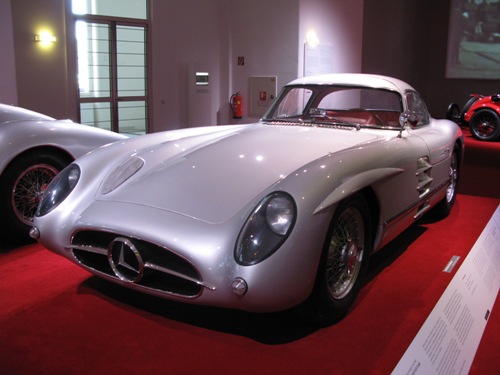
Horch Typ 951 A Pullman-Cabriolet
1939
Automobiles by Horch were once among the most sought-after luxury cars. In Germany, they dominated the upper segment of the automobile industry in the 1930s. Within the Auto-Union formed in 1932 with Audi, DKW, and Wanderer, the Horch works in the town of Zwickau in the state of Saxony specialized in the development and construction of exquisite representative vehicles, aimed at an elitist clientele. After the Nazis came to power and the first-line management was replaced in full, the company's order books featured the names of high-ranking party officials. One of them was Baldur von Schirach, Reichsjugenfuehrer (Reich Youth Leader) and between 1940 and 1945 Gauleiter and Statthalter (Governor) of Vienna, and as such responsible for the deportation of 1855,000 Austrian Jews to concentration camps.
Schirach clearly enjoyed traveling in comfort, for this Cabriolet, with its superstructure by the Berlin luxury coachbuilder Erdmann & Rossi leaves nothing to be desired: blue armchair leather with matching carpeting and ceiling fabric covering, cord drapes, folding table, reading lamp, dual loudspeaker radio, and mat-polished exotic wood appointments in a dark-blue sedan body with all-around trim mouldings and extended black mudguards. It must have been a bizarre sight to see this automobile driving among the heaps of rubble as it purred its way through a partly destroyed Vienna. Schrach died in 1974, a free man, after serving out a twenty-year prison sentence.

Porsche 356 1300 Coupé
1951
It was Porsche's first production automobile and it came from Austria. The first fifty 365s were hand-made in Gmünd in Carinthia, to where the Porsche design department had relocated from Stuttgart towards the end of the Second World War. On 8 June 1948, the provincial government of Carinthia granted a special approval for the first prototype. While the design concept was based on another tried-and-tested Porsche design with air-cooled boxer rear-engine, crank pivot axle at the front, and swinging axle with torsion-bar springs at the rear, it was re-engineered with a focus on sporting performance. In other words, the VW Beetle was given its wings. In appearance, the 356 also testifies to the hereditary proximity to its rather "frumpish forbear". And indeed, both curved body designs were by Erwin Komenda. Initially, the first Porsche generation with split windshield mad of Sekuritglas was available only with a 1.1 litre Volkswagen engine. It was a good year after production was relocated to Stuttgart-Zuffenhausen in 1950 that the 1.3 litre model series was presented, from which this Chrome Jewel Porsche originates, and the same year a 1.5 litre variant was also launched. Two 1.6 litre Porsches with up to 115 bhp were introduced in the late 1950s before its successor, the 911, in 1965, by which time a total of 76,302 356s had been manufactured.

Mercedes-Benz 300 SLR Coupé
(Uhlenhaut Coupé)
1955
Bentley, Bugatti, Ferrari: With many manufacturers of luxury cars, the often charismatic individuals who gave their name to their marque often single-handedly shaped their development and fate; this was unthinkable in the case of Mercedes. Here, the focus was always on team, never on the individual personality – with one exception: even today, the name Rudolf Uhlenhaut has a legendary ring to it with the Group.
Unlenhaut was born in London in 1906 and came to Daimler-Benz in 1931, where he rose to the position of head of the racing department after only a few years. With him, successes on the race track returned, and so after the Second World War he was entrusted with the comeback of Mercedes in the world of motor racing. He designed the legendary Gullwing 300 SL.
For long distance races, Uhlenhaut combined this design principle of a closed body with the Grand Prix engine technology of the W196R. The two Mercedes-Benz 300 SLR (W 196S) prototypes, generally referred to as the "Uhlenhaut Coupés", were created in this way. However, they were never used in racing conditions as Mercedes-Benz pulled out of motor racing in 1955.
Not that the Coupés were withdrawn from circulation – far from it. With this 300 SLR company car, the audacious Uhlenhaut is said to have driven the journey between Stuttgart and Munich in under two hours. In the only test report of its day, the Swiss Automobil-Revue glowingly wrote: "we're driving a car that makes 200 km/h seem like dawdling."
